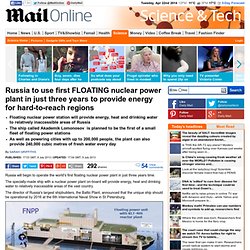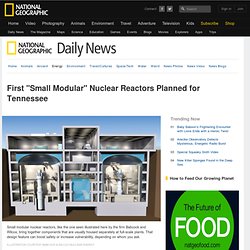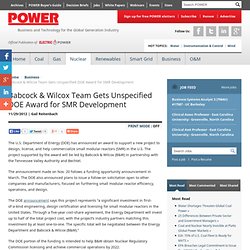

Centrales immergées: un autre avenir pour le nucléaire? Dans les grands pays industriels qui ont poursuivi un programme nucléaire après Fukushima – États-Unis, Chine, Russie, Corée du Sud et peut-être bientôt à nouveau le Japon – les petits réacteurs modulaires (SMR, Small Modular Reactors) commencent à être considérés, à côté des réacteurs de forte puissance tels que l’EPR, comme une des voies du renouveau du nucléaire.

L’Agence internationale de l’énergie atomique (AEIA) y voit une solution intéressante pour les pays nouvellement industrialisés. Plusieurs arguments jouent en effet en leur faveur. Le premier est leur coût modéré, le second leur capacité à servir de petits marchés, avec des réseaux électriques qui n’ont pas été conçus pour absorber la puissance d’une centrale traditionnelle. NuScale Puts Single-Minded Focus on Small Modular Reactor. The western U.S. could host the first NuScale small modular reactor, which traces its roots to Oregon State University.

Financial backing from Fluor Corp. could make the design more than an academic exercise and provide a scalable, carbon-free electric power source by the mid-2020s. The global nuclear industry has endured a rough patch since March 2011, when an earthquake and tsunami crippled the Fukushima Daiichi nuclear station in Japan. Attention in the U.S. after the accident focused on the ability of nuclear reactors to safely shut down in the event of a loss of power to water circulating pumps critical in keeping the reactor core cool. The Nuclear Regulatory Commission (NRC) adopted a number of recommendations for operators to follow, including enhancing the capability of operators to maintain plant safety during a prolonged loss of electrical power. Considering safety, Dr. Russia to use first FLOATING nuclear power plant in just three years time to provide energy for hard-to-reach regions.
Floating nuclear power station will provide energy, heat and drinking water to relatively inaccessible areas of RussiaThe ship called Akademik Lomonosov is planned to be the first of a small fleet of floating power stationsAs well as powering cities with up to 200,000 people, the plant can also provide 240,000 cubic metres of fresh water every day By Sarah Griffiths Published: 17:03 GMT, 9 July 2013 | Updated: 17:04 GMT, 9 July 2013 Russia will begin to operate the world's first floating nuclear power plant in just three years time.

The specially-made ship with a nuclear power plant on-board will provide energy, heat and drinking water to relatively inaccessible areas of the vast country. The director of Russia's largest shipbuilders, the Baltic Plant, announced that the unique ship should be operational by 2016 at the 6th International Naval Show in St Petersburg. First "Small Modular" Nuclear Reactors Planned for Tennessee. Near the banks of the Clinch River in eastern Tennessee, a team of engineers will begin a dig this month that they hope will lead to a new energy future.

They'll be drilling core samples, documenting geologic, hydrologic, and seismic conditions—the initial step in plans to site the world's first commercial small modular nuclear reactors (SMRs) here. (See related quiz: "What Do You Know About Nuclear Power? ") Once before, there was an effort to hatch a nuclear power breakthrough along the Clinch River, which happens to meander through the U.S. government's largest science and technology campus, Oak Ridge, on its path from the Appalachian Mountains to the Tennessee River. In the 1970s, the U.S. government and private industry partners sought to build the nation's first commercial-scale "fast breeder" reactor here, an effort abandoned amid concerns about costs and safety.
Le réacteur nucléaire ATMEA1 vise le marché brésilien > Nucléaire. Le consortium ATMEA, comprenant Areva et Mitsubishi Heavy Industries (MHI), a présenté à Rio de Janeiro le réacteur nucléaire ATMEA1 ainsi que la stratégie de localisation de l'entreprise pour la construction de ce dernier au Brésil.

L'évènement, qui a rassemblé près d'une centaine de participants représentant les principales parties prenantes du secteur nucléaire au Brésil, a été selon Areva "un franc succès et le théâtre de débuts prometteurs pour de futures collaborations avec l'industrie brésilienne. " "L'expertise industrielle et l'expérience sont les deux clés du succès de tout projet nucléaire.
Babcock & Wilcox Team Gets Unspecified DOE Award for SMR Development. The U.S.

Department of Energy (DOE) has announced an award to support a new project to design, license, and help commercialize small modular reactors (SMR) in the U.S. The project supported by the award will be led by Babcock & Wilcox (B&W) in partnership with the Tennessee Valley Authority and Bechtel. The announcement made on Nov. 20 follows a funding opportunity announcement in March. The DOE also announced plans to issue a follow-on solicitation open to other companies and manufacturers, focused on furthering small modular reactor efficiency, operations, and design. The DOE announcement says this project represents “a significant investment in first-of-a-kind engineering, design certification and licensing for small modular reactors in the United States. The DOE portion of the funding is intended to help B&W obtain Nuclear Regulatory Commission licensing and achieve commercial operations by 2022.
Sources: POWERnews, DOE.